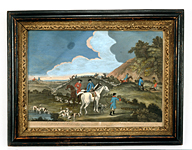| Maker(s): | Burford, Thomas; Seymour, James (possibly)
| | Culture: | English
| | Title: | print: Diging for the Fox. Deterrer le Renard.
| | Date Made: | 1767
| | Type: | Print
| | Materials: | paper, ink, watercolor, wood, glass, paint, gilt
| | Place Made: | United Kingdom; England
| | Measurements: | Frame: 14 1/8 x 18 x 15/16 in; 35.9 x 45.7 x 2.4 cm; Sheet: 10 7/16 x 14 7/16 in; 26.5 x 36.7 cm; Plate: 9 7/8 x 14 in; 25.1 x 35.6 cm
| | Accession Number: | HD 1659.3
| | Credit Line: | Gift of Joseph V. Reed
| | Museum Collection: | Historic Deerfield
|
|

|
Description:
Hand-colored engraving titled: "Diging for the Fox. Deterrer le Renard"; and "Design'd & Published as the Act Directs by Thos. Burford, Septr. 9. 1767". After the fox has been located, dogs--usually corgis--dig to uncover it. This print, a line etching with burin work on paper with watercolor, depicts a landscape with foxhunters on horseback and standing with many hounds with a small hill in center and to the right and an open field with water in the bottom left corner. The original frame is painted black with an inner liner of sanded and carved decoration in gilt. Seymour hunting prints were advertised in a 1775 catalogue from London that was sent to a Philadelphia printseller making their purchase easy for Americans. For much of the 18th century, the most popular print size was 14" x 10"; landscape prints were normally larger, running from 12" x 18" to 18" x 24". Although prints were available framed, or frames could be ordered ready-made from London, many people wanted custom-made frames so that American printsellers often imported molding by the linear foot. The typical frame style was ebony or ebonized (painted black), sometimes with carved gilt detail such as this example.James Seymour is recognized as one of the earliest English sporting artists. He was the son of a wealthy goldsmith and diamond merchant who supplied the plate for racing trophies. His father was also an amateur artist and a member of the Virtuosi Club of St. Luke, a gentleman's club for artists and art lovers. The young Seymour had no formal art instruction but he learnt to draw by studying the pictures and prints in his father's collection. At an early age he was introduced to some of the leading artists of the day, but at the same time he was encouraged to develop a love of the track, which eventually lead to his financial ruin. Seymour was passionate about racing and in addition to drawing and painting them he is believed to have owned racehorses himself. With his prolific output and supe
Link to share this object record:
https://museums.fivecolleges.edu/detail.php?t=objects&type=ext&id_number=HD+1659.3 |